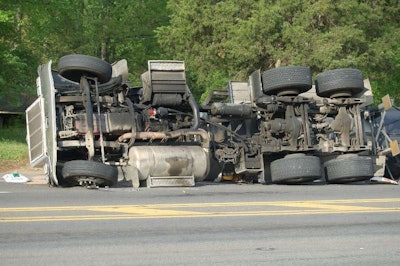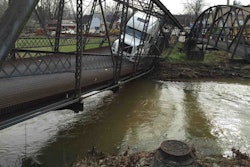
Here are the raw numbers:
As you can see, they remained high compared to years 2009-10, but hopefully this translates to a trend in the numbers through 2014 — we won’t have those stats from NHTSA for quite a while — lower and lower. Something to keep an eye on.
Overall for crash fatality statistics, truck-involved fatalities rose slightly in 2013, according to NHTSA, from 3,944 to 3,964 deaths, including those truck occupants. The total number of truck-involved accident injuries, however, was down substantially in 2013 — a 9 percent decline to 95,000. Again, here’s hoping it continues.
The Chicago Tribune recently ran this story via Bloomberg exploring antiquated highway off-ramps and cloverleaf intersections and how they might be contributing to truck-driver deaths. Part of the story leads into exploration of the hold-up of NHTSA’s work on a rule to mandate Electronic Stability Control in new trucks, which Bendix reps at the Mid-America Trucking Show last week speculated would be on the books this year.
Bendix director of government affairs Fred Andersky: electronic stability control mandate final rule: "will come out this year"
— Todd Dills (@channel19todd) March 25, 2015
Watchers hope such technology, widely utilized, will ultimately reduce the risk of truck rollovers, whether infrastructure is designed better to help mitigate them or not.
[gtblockquote source=”USF Holland driver Herschel Evans in the Chicago Tribune/Bloomberg story about navigating outdated, dangerous off-ramps and cloverleafs in his primary area of operation, Atlanta” border_color=”#e4e5e3″]”We can’t afford a bad day or an off day…. We’ve got to bat 1,000 every day. When we don’t bat 1,000, we stand out.” –USF Holland driver Herschel Evans in the Chicago Tribune/Bloomberg story about navigating outdated, dangerous off-ramps and cloverleafs in his primary area of operation, Atlanta
And whether or not the profusion of reckless passenger-vehicle drivers is mitigated. Overall, the Tribune/Bloomberg story’s worth reading, but it’s the framing anecdote that is its most telling feature. Reporter Keith Naughton tells the story of Walter Price’s rollover at the No. 1 hotspot for such truck accidents, according to an American Transportation Research Institute study: Exit 238-B on I-75 in Georgia. As Price began to exit there, a four-wheeler darted in front of him and quickly slowed to take the exit. In his move to evade the four-wheeler, Price (with his wife asleep in the bunk) couldn’t keep the rig upright.
Toward the end of the piece, driver Price, writes Naughton, gives us the ultimate fate of that four-wheeler: “He just kept on driving, like they always do. … They create accidents and they keep on driving like nothing happened. It’s brutal out here.” Read the full piece via this link.










